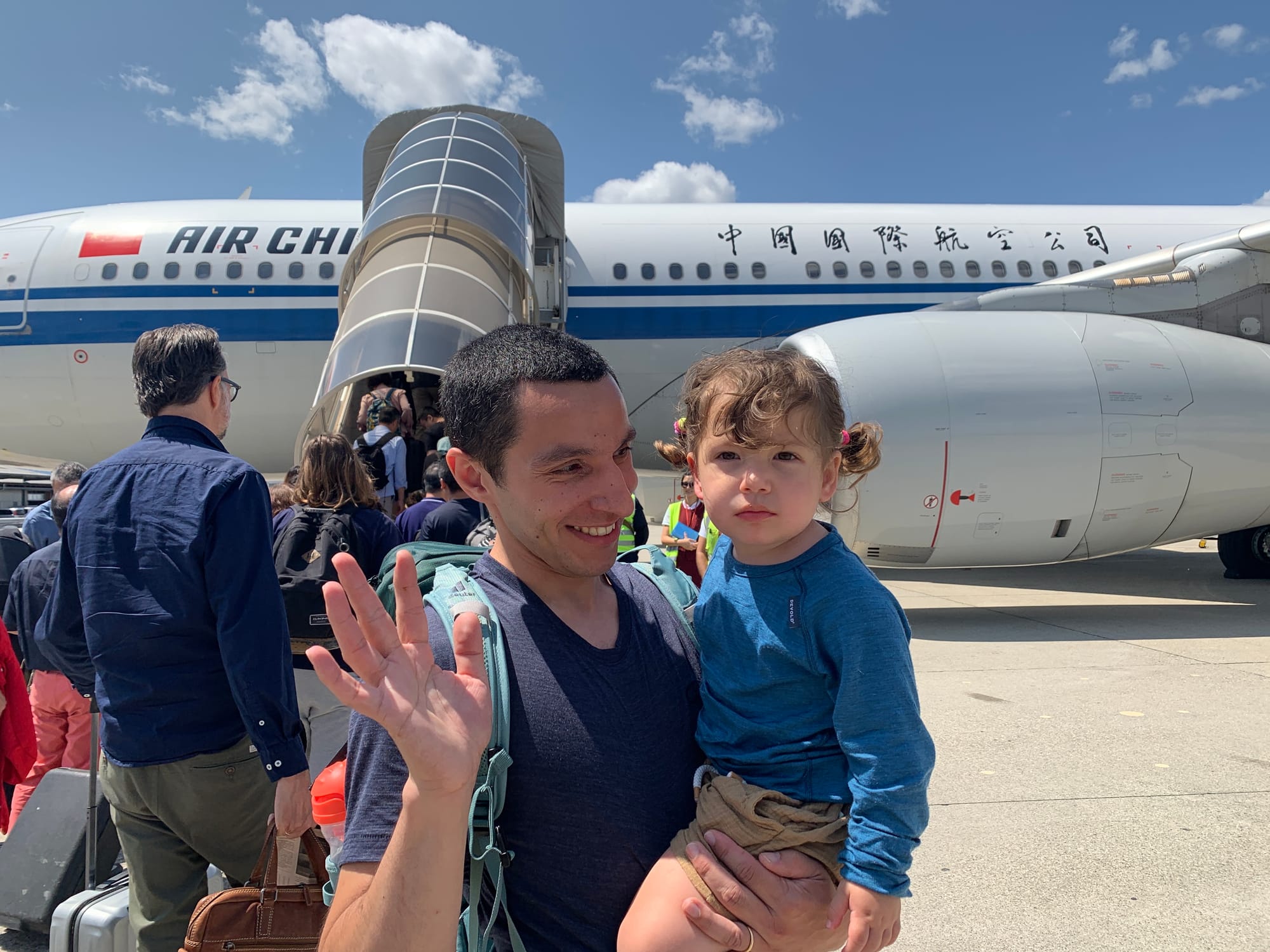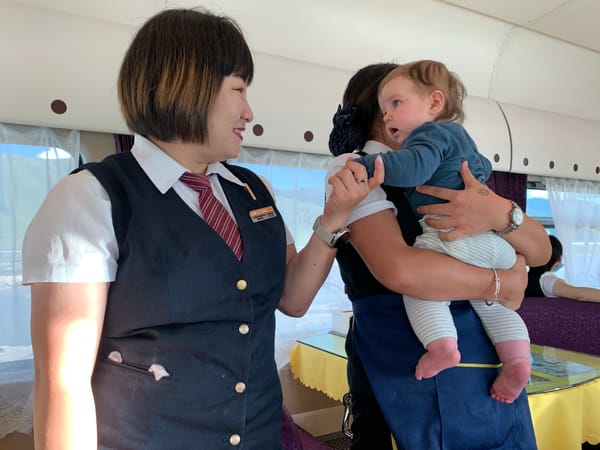Flying with young children, especially on long-haul flights, can be one of the most stressful aspects of traveling as a parent. The thought of managing tired, restless kids in cramped spaces is enough to make many families hesitate before booking a trip. Personally, flying has always been the part of travel I dread most, and adding kids into the equation takes it to a whole new level.
Not only are you likely exhausted from disrupted sleep and the general discomfort of air travel, but you also become your child's sole source of entertainment—just when they need to stay still the most!
In this post, I’ll share tried-and-tested tips to help make flying with kids less of a nightmare and more of a manageable adventure. So fasten your seatbelt—it’s going to be a bumpy (but rewarding) ride!
TL;DR: Actionable Tips for Flying with Small Kids
- Book flights during your child's usual sleep times
- Pack a well-stocked carry-on with essentials and entertainment
- Arrive at the airport early to allow extra time for security and unexpected needs
- Consider using a child harness or leash in busy airports
- Bring snacks and an empty water bottle to fill after security
- Use new toys or activities as surprises during the flight
- Encourage kids to suck on a pacifier, bottle, or snack during takeoff and landing
- Dress in layers and bring extra clothes for everyone
- Practice calm and patience when dealing with meltdowns or delays
- Plan for jet lag recovery, especially for international flights
For detailed information on each tip and more, read the full article below.
Pre-Flight Planning
Successful air travel with kids starts long before you reach the airport. Here are key considerations for your planning phase:
Choosing Flights
- Select flight times that align with your child's sleep schedule when possible
- For longer journeys, consider breaking up the trip with a layover to allow kids to stretch and burn off energy
- Look for child-friendly airlines that offer pre-boarding for families or have good reputations for accommodating children
Airline Policies
- Research airline policies regarding car seats, strollers, and carry-on allowances for children
- Some airlines offer bassinets for infants on long-haul flights – book these in advance if available
Packing Essentials
Make sure to pack a small bag to keep accessible under the seat with everything you might need during the flight, and keep the bigger carry-on stored away during the whole flight in the overhead compartment. You don't want to be going through a suitcase or a backpack during the flight
It is generally a good practice, but indispensable when flying with kids.
Keep those items easily accessible:
- Diapers, wipes, and changing supplies
- Change of clothes for kids (and a spare shirt for adults)
- Snacks and empty water bottles
- Comfort items (favourite toy, blanket)
- Entertainment (books, colouring supplies, games)
- Basic first-aid items and any necessary medications
We personally don't take any kind of travel beds, pillows or anything of that kind. We are huge fans of the concept of traveling light and we rather suffer during the 10 hour flight then be forced to travel with extra 10kg of stuff that supposedly makes traveling easier.
Airport Navigation
Navigating the airport with small children requires extra time and patience.

Arriving At the airport
Although some might advise you to come early to the airport, I generally aim not to have too much spare time. You don't want kids to get bored already before the flight!
- Make sure you know how big and busy the airport you are flying from is. While our home Zurich Airport is usually smooth to go through, big international airports like Frankfurt or Beijing can be crowded
- Many airports have special lanes for parents traveling with small children, so you might be able to skip the queue: make sure to know the rules in advance
- Keep a small buffer that allows for unexpected diaper changes, snack breaks, and security delays




Security Screening
- It is a good idea to explain the security process to older children beforehand - this will make easier to understand what and why is being done. It might even replace the crying and whining entirely with curious looks and a series of "why" questions.
- Have liquids and electronics easily accessible for screening. You don't want to be unpacking entirely just to take out a 50ml packet of face wash.
- Think about what you want to do with the pram as you have multiple options. You are allowed to keep the pram right until boarding the plane (or even store it in an overhead compartment if you have a pram that folds up to fit in there). However, if you are not short on time but rather on hands (single parent traveling with more one kid?), you can also check in the pram for free.
- If traveling with a stroller, you should empty the stroller ahead of time as they will ask you to do it at security screening. And it is not fun to look through every pocket to find last item you tucked in there.
- Ask for assistance if traveling alone with multiple children
Family-Friendly Services
- Locate play areas or family lounges for pre-flight entertainment. When traveling with kids the airport time is the last free movement time ahead of the flight, so don't be too strict on keeping still and quiet. Best to run a bit at the airport then later on the plane
- Use nursing rooms or quiet areas for feeding and calming children

Boarding and In-Flight Comfort
Boarding Strategies
- Decide whether to pre-board (more time to settle) or board last (less time confined to the plane). While many airports offer priority boarding for parents traveling with kids, it might still be a good idea to board last. If traveling with big luggage on a fully booked flight, on a small plane, better to board early
- Remember that if you are taking a bus to board the plane, you will still be boarding the plane all together, so better to wait in front of the gates then inside the bus. Plus, getting on the bus last means you are closer to the door when getting off.
- If traveling with a partner, consider having one adult board early with gear while the other waits with the children

Car Seats and Strollers
- Check if your car seat is approved for air travel
- Gate-check strollers for easy access upon landing
Seating Arrangement
Book seats together, preferably near the front of the plane for quicker deplaning.
On long haul flight, if you travel with an infant that doesn't have their own seat (especially small baby that sleeps a lot), it might be a good idea to book 1 parent + older child, and then separated by the corridor 1 parent + infant on the lap. This way one parent can dedicate their attention to entertaining the child while the other parents holds the uninterrupted sleeping baby.
Keeping Kids Entertained
Maintaining your child's interest during the flight is crucial for a peaceful journey:
Age-Appropriate Activities
- For infants: Soft toys, teething rings, board books
- For toddlers: Sticker books, magnetic drawing boards, drawing tablets, water colouring books
- For older children: Activity books, card games, small LEGO sets
Airlines often offer kids some small games, toys, puzzles etc.


Surprise Elements
- Take small toys or activities to be unveiled throughout the flight
- New or special snacks can also serve as exciting reveals
Make sure you are using as little entertainment as possible. As long as your kid is just happy chatting or playing pick-a-boo, don't take out any toys.
Keep the most exciting foods and games for lasts. Once they are generally tired and cranky it will become more difficult to entertain them, so start with the obvious boring stuff, moving up the excitement ladder.
Managing Food and Drinks
Snack Preparation
- Pack a variety of healthy, mess-free snacks.
- Include some special treats for rewards or distractions
Some of our favourite snacks:
- bread rolls
- whole-grain biscuits
- dried fruit (not too much though)
- home-made banana bread
- grissini
- flips
Airline Meals
- Request child meals in advance if available
- Bring familiar foods in case your child refuses airline offerings
- It is a good idea for everyone to order a different meal - this way you maximise the chances that the kids will accept something
Hydration
- Encourage regular drinking to prevent dehydration
- Avoid excessive sugary drinks that might lead to hyperactivity
Health and Comfort
Ear Pain Prevention
- Encourage swallowing during takeoff and landing (nursing, bottle feeding, or chewing for older kids)
- Consider paediatric ear plugs designed for air pressure changes
Sleep Tips
- Maintain bedtime routines as much as possible
- Bring comfort items from home (small pillow, blanket)
- Consider inflatable foot rests to create a flat surface for small children to lie down
- For toddlers and babies, it might be easiest to put them asleep in the carrier if they are used to it

Diaper Changes and Bathroom Breaks
Airplane Bathrooms
- Change diapers right before boarding
- Practice using airplane bathrooms with older toddlers before the flight
Changing in Tight Spaces
- Bring a small changing pad for diaper changes at your seat if necessary
- Pack disposable changing pads for easier cleanup
Handling Disruptions
Delays and Cancellations
- Have a backup plan for entertainment during extended waits
- Know your rights regarding accommodations for significant delays
Mid-Flight Meltdowns
- Stay calm and remember that most passengers understand the challenges of traveling with kids, focus on your child
- Use distraction techniques or take a walk down the aisle if possible
Passenger Reactions
- Apologise briefly if your child is disruptive, but don't overdo it
- Focus on addressing your child's needs rather than worrying about other passengers
Arrival and Post-Flight
Navigating Arrival
- Have one adult collect luggage while the other manages the children
- Use airport services like luggage carts or porters if needed
- Don't rush out of the plane and make sure you collected everything from the plane
Time Zone Adjustment
Remember that jet lag occurs when traveling to the timezones with later time. If traveling to somewhere that time is behind, you will naturally just wake up early feeling fresh, but also collapse early in bed in the evening.
- Gradually adjust to the new time zone over a few days if possible
- For short holiday, best would be not to "fully adapt" - it is ok if your child keeps eating late dinners and goes to bed late and wake up later. This way adjusting back to your own timezone is easier.
- Maintain consistent wake and sleep times to help adaptation
Flight Recovery
- Plan for a low-key first day at your destination
- Allow time for rest and adjustment before starting activities
Special Considerations
Age-Specific Tips
- Infants: Consider nursing or bottle feeding during takeoff and landing
- Toddlers: Bring activities that involve fine motor skills to keep hands busy. Also remember to give them some snack during takeoff and landing
- Older children: Involve them in the travel process, like carrying their own small backpack
Multiple Children
- Don't expect the older child to be absolutely unproblematic, it is challenging for them too
- Consider giving older siblings responsibilities to keep them engaged
International Travel
- Research vaccination requirements well in advance
- Bring copies of important documents (passports, birth certificates)
Conclusion
Flying with small children doesn't have to be a dreaded experience.
With careful planning, realistic expectations, and a positive mindset, you can make air travel an exciting part of your family adventures.
Remember that each flight gets easier as both you and your children become more experienced travellers. Embrace the journey and create lasting memories, knowing that the destination will be worth the effort.
By following the tips in this guide and adapting them to your family's specific needs, you'll be well-prepared to handle the challenges of air travel with young children. Safe travels and enjoy your family adventures!










Member discussion